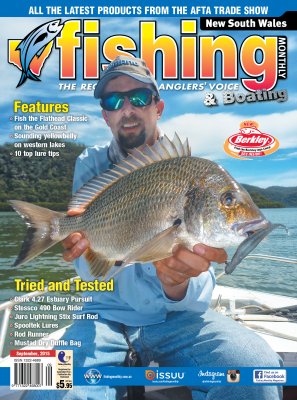Top 10 tips for luring by Jamie Robley
 At this time of year, with warmer weather and more daylight hours many anglers turn their attention to casting lures rather than good old natural bait. Common species such as bream, flathead and bass become more active now and will continue to do so as we move through spring, towards summer.
At this time of year, with warmer weather and more daylight hours many anglers turn their attention to casting lures rather than good old natural bait. Common species such as bream, flathead and bass become more active now and will continue to do so as we move through spring, towards summer.
During this earlier part of spring though, many fish still haven't fully woken from their cold water doldrums and may not yet be overly enthusiastic about hitting lures. Because of this, it's easy to assume that lures may simply not be working and a switch back to bait soaking is a better idea. To some extent this may be true, but for those who really want to get this lure fishing business sorted, it's best to persist.
Something else that is important to understand is that the lure fishing game is a bit different to using baits. The biggest individual difference is that lure casting is largely about the angler moving around and casting to seek out fish, while drowning a natural bait is a way of attracting fish towards your offering, which is generally in a stationary position.
Casting lures and actively looking for fish can be done from shore-based spots, by wading around shallows, from a kayak or a powered boat. Whichever approach the angler takes, the following ten tips are all valuable and when combined, that all important success or goal should be achieved.
SPECIFIC TARGET
As with any form of fishing, from outback creeks through to your local estuary or deep offshore waters, aiming for a particular species will always have an advantage over simply getting out there and hoping for 'something' to come along.
By specifically targeting one fish or another, you'll be setting yourself up with appropriate tackle or lures for that species. Of course, doing a bit of research by talking to mates and reading fishing reports or articles should provide a clearer picture of exactly how to go about catching the fish.
Bream, flathead, tailor, mulloway, cod or bass all bite lures and all have some things in common, but they're all different to each other and respond to different lures and techniques, so pick a target and aim for it.
LOCATION
Of course, heading to a suitable location is the next step and once again, each species has its preferred habitat. While species like bream are very widespread and it's not hard to find a spot worthy of putting in some time casting lures, other fish like mulloway or Murray cod are much more specific in their habitat requirements and this could mean a long drive or quite a few hours spent just to reach a spot worth trying.
While this seems incredibly obvious, such basics are a vital part of the lure fishing game and repeatedly casting for hours in the wrong place can soon diminish an angler's enthusiasm.
So firstly consider your target species, then factor in whether it's worth chasing in your area or will it require time and effort to reach a place where the fish are more likely to be.
TIMING
As a broad guideline, most fish in the fresh or salt are more active and looking for a meal around sunrise and sunset. So casting lures during these short periods for anything ranging from bream and bass to tailor or trout tends to be more successful than persisting through the middle of the day.
Most saltwater species also react according to tides and water movement. In many cases a rising tide is good, but a falling or outgoing tide may also be fine for some species in some locations. Most fish go off the bite and sulk during the slack water, around the top or bottom of the tide. In some places though, mulloway or other predators use this calm period to hunt their prey.
Understanding a little bit about the target species helps an angler decide exactly when or when not to put in the effort. If in doubt, simply concentrate more around sunrise or sunset to begin with.
TACKLING THE TASK
Nicely balanced tackle that isn't too heavy to use for a few hours at a time goes a long way towards success. A lightweight outfit is more enjoyable when casting and fighting a fish. In most cases, lighter gear also translates to more efficient casting to attain distant and accuracy.
The outfit needs to match the lure weights being used, the chosen target species and the environment. So an ultra-light 2kg outfit may work great for bream out in open lakes, but when chasing the same species around oyster racks or a creek full of timber snags it's best to use beefier gear, which may also be a bit heavier in weight.
Similar comparisons can be made when casting lures from a beach or boat for tailor compared to doing the same thing from the ocean rocks. You may be throwing the same lure weights for the same sized fish, but the rocks, cunje, kelp and wave action mean that a much longer and heavier rod is required to achieve similar results.
Good gear certainly isn't always about using more expensive stuff. Replace the word expensive with 'suitable' or 'appropriate' and you're on the right track.